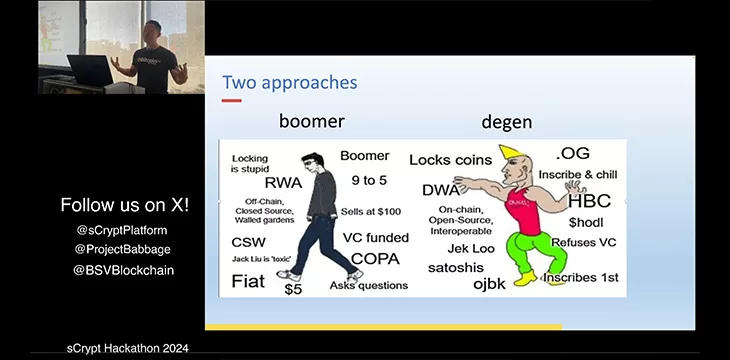|
Getting your Trinity Audio player ready...
|
“It’s an interesting time to be here,” said sCrypt Co-Founder Xiaohui Liu at the kickoff session for his company’s latest Hackathon event. Thanking the developers and other interested parties who showed up in person, he reminded everyone that “we’re here for the tech” and that the future of both Bitcoin and blockchain lay in building apps the “average Joe” could use in daily life. The search is still on for Bitcoin’s killer app, he added.
The sCrypt Hackathon officially takes place from March 25 to April 25, 2024, and registrations are still open for developers. The introductory presentations happened at San Francisco’s Fairmont Hotel, but the actual work will occur online and worldwide.
The kickoff event was streamed and recorded, and anyone interested can re-watch the complete morning and afternoon sessions by following the links below.
Xiaohui Liu drew several parallels between his team’s work at sCrypt and the Hackathon venue in San Francisco. The Fairmont Hotel hosted a large number of conference delegates and discussions for the 1945 United Nations Conference on International Organization, the event that produced the original UN Charter. San Francisco itself was also a major base and arrival point for the California Gold Rush of the 1840s-50s. Newcomers to the gold rush wanted in on the action and wanted to get rich, but couldn’t do it bare-handed. sCrypt’s job, Liu said, was to produce the shovels and pickaxes for those wishing to work hard and join blockchain’s own rush.
“That’s what we’re offering here. We want you to succeed. All the developers here go out and use the many features of Bitcoin to strike some gold. To build that killer app, the app that takes us into the mainstream.”
The tools work no matter whether you’re a Bitcoin maximalist or chain-agnostic, he added. He also pointed out the two worlds of potential blockchain devs: the “boomer” approach working on enterprise, regulation, VC funding, and bringing blockchain into the mainstream tech world, and the (younger) “degen” approach looking at NFTs, Ordinals, “locking” assets, and other conceptually-fresh use cases the boomers had trouble relating to. Although the two worlds are very different, they don’t have to be mutually exclusive and both kinds of energy need to be in the room.
“A lot of times it takes tinkering, experimenting” before any killer app emerges, and that’s what developers do. Liu described the current Web3 situation, saying its number of developers was still relatively low. However, the concepts of smartphones as wallets and a user-centric internet that controls access to their own data and can swap digital tokens across blockchains allow plenty of opportunities.
sCrypt’s work is primarily in smart contracts, and the contract use case generating the most buzz is tokens, Liu said. The 1SatOrdinals protocol on BSV allows token registration using a single satoshi unit (Bitcoin’s smallest unit for transactions), and they can be used as a digital representation of almost anything.
“Once you have the tokens, you can bring this into another dimension,” he said. Anything could be represented by tokens, from land registries to hotel room access and concert tickets count as assets.
1SatOrdinals protocol developer David Case described how the simple approach to NFTs works, creating a globally unique identifier for a single satoshi and rules for tracking that satoshi across many transactions. It’s computationally expensive to calculate and track all these tokens at scale, he said, but using a single sat to represent a token made for easier indexing based on each token’s origin.
In the afternoon session, sCrypt co-founder Yiqiang Wang went into more detail on the company’s new Ordinals SDK, which combines 1SatOrdinal token registration with contract logic. It’s “a very sophisticated way to manage the tokens,” he said, which supports both fungible and non-fungible tokens (NFTs) and uses a standard P2PKH locking script for the contract without any other requirements or dependencies.
Founding President of Project Babbage, Ty Everett, also spoke at the event, saying sCrypt’s advanced transaction capabilities and native UTXO-first integration provided a sophisticated smart contract platform for developers to leverage. He described Project Babbage’s role as similar to that of sCrypt, providing the tools for developers to produce compelling apps for users.
“We do this stuff because we believe in these things… and that’s important,” he said.
Watch: Tokens on BSV? 1Sat Ordinals and sCrypt

 12-17-2025
12-17-2025 





